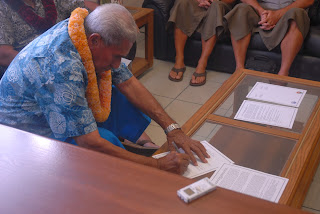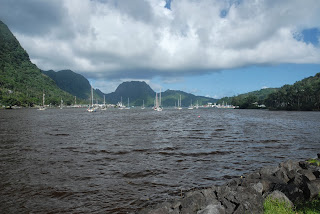American
Samoa National Park Service’s Super Intended James Bacon also signs the
agreement because the area that is going to be a no take zone is part of the
national park. Thanks for National Park Services with working
collaboratively with the village of Fagasa and the Department of Marine and
Wildlife Resources to preserve and protects American Samoa's resources.
The Department Of Marine & Wildlife Resources

Wednesday, October 30, 2013
Lupefa'alele Tua the mayor of the village of Fagasa signing the agreement to establish a No-Take MPA in Fagasa.
Atuatasi Talosaga a High Talking Chief that represented the village council of Fagasa signing the agreement.
Atuatasi Ieremia another High Talking Chief that represented the village of Fagasa signing the agreement.
Atuatasi Talosaga a High Talking Chief that represented the village council of Fagasa signing the agreement.
Atuatasi Ieremia another High Talking Chief that represented the village of Fagasa signing the agreement.
Director of the Department of Marine and Wildlife Resources
Dr. Ruth Matagi-Tofiga signing the agreement to establish a no take marine protected area in the village of Fagasa on October 29, 2013. She mentioned that this is a milestone since her time here working with the department. The village of Fagasa are willing to work together with the department on managing their marine resources for future generations and the people of American Samoa.
Dr. Ruth Matagi-Tofiga signing the agreement to establish a no take marine protected area in the village of Fagasa on October 29, 2013. She mentioned that this is a milestone since her time here working with the department. The village of Fagasa are willing to work together with the department on managing their marine resources for future generations and the people of American Samoa.
Water Samples analyze by Dr. Don Vargo at American Samoa Community College Land Grant
This is a photo that was taken under a microscope by Dr. Don Vargo at American Samoa Community College Land Grant. Water samples have been sent off to Dr. Steve Morton, head of the Marine Biotoxins Program based in Charleston, South Carolina. Dr. Morton identified it as Prorocentrum micans.
This is a photo that was taken under a microscope by Dr. Don Vargo at American Samoa Community College Land Grant. Water samples have been sent off to Dr. Steve Morton, head of the Marine Biotoxins Program based in Charleston, South Carolina. Dr. Morton identified it as Prorocentrum micans.
On October 17, 2013 this photo was taken from the FIFA Soccer Field in Pago Pago of an Algal Bloom. The Department of Marine and Wildlife Resources collected water samples from within the harbor and outside the Fagaloa area for further research. Studies have shown that a large bloom of this species usually occurs with the combination of high levels of phosphate. This plankton or tiny marine algae is usually brown red at the beginning when it blooms followed by a black brown color at the final stage.
Microscope photograph of the Ceratium furca dinoflagellate samples in Pago Pago Harbor
Subscribe to:
Comments (Atom)







